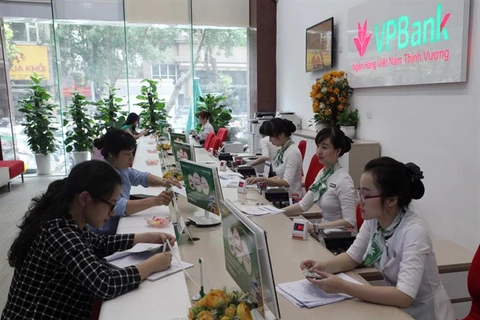Hanoi (VNA) - The banking sector’s profits were anticipated to rise significantly in 2017, driven by the handling of bad debts and the recovery of the property sector.
This would create room for rate cuts, according to the National Financial Supervisory Committee (NFSC)’s report launched on December 26.
The report on the 2017 financial market predicted that the pre-tax profits of the banking sector would rise more than 40 percent over the previous year and after-tax profits by 44.5 percent.
Truong Van Phuoc, the NFSC’s Acting Chairman, said this was thanks to the handling of bad debt, hastened by the National Assembly (NA)’s Resolution 42/2014.
The NFSC’s report revealed a higher-than-reported bad debt ratio at 9.5 percent, much higher than the ratio of below three percent reported by banks and the ratio of 8.61 percent (including potential bad debts and debts purchased by the Vietnam Asset Management Corporation) that Governor of the State Bank of Vietnam Le Minh Hung reported at a hearing of the NA in November.
However, NFSC found that bad debts reduced significantly in 2017. Some 70 trillion VND (3.07 billion USD) worth of non-performing loans were handled in 2017, up 40 percent against 2016, according to the report.
The warming of the real estate market also helped promote the credit flow, Phuoc said.
The NFSC’s report estimated that credit growth would be some 19 percent this year. Total assets of the banking system increased by 17.3 percent and the system had good liquidity due to the net purchase of $7 billion by the State Bank of Vietnam to increase foreign currency reserves.
“With better profits, credit institutions will have more room to reduce loan interest rates,” Phuoc said.
In September, the Government asked the central bank to cut loan interest rates by 0.5 percent by the end of 2017 in an effort to support businesses and fuel economic growth.
However, lowering rates isn’t so simple.
Financial and banking expert Can Van Luc said pressure from inflation next year and handling of bad debts together with high capital demand would make it difficult to lower rates.
Previously, Hung said lowering interest rates would depend on many factors, such as the macroeconomic situation, capital demand-supply, exchange rate policies, inflation and system liquidity. He said that lowering rates was the target of the central bank.
The NFSC projected Vietnam’s economic growth at 6.5-6.8 percent in 2018, close to the NA’s target of 6.5-6.7 percent.
Dang Ngoc Tu, from the NFSC, said growth rate of 6.5 percent would be the best scenario, in which there would be little pressure on inflation.
In the growth scenario of 6.8 percent, measures to stimulus demand must be applied, inserting pressure on inflation in 2018.
The economic growth would benefit from improving exports as well as a better business climate.
The NFSC said the private sector would continue to be the major driver for growth in 2018.
However, Industry 4.0 is bringing rapid changes, which would benefit countries with high technology but undermine competitiveness of economies which rely on cheap labour and exploitation of natural resources.
“It time for Vietnam to take advantage of Industry 4.0 to avoid being left behind,” he said.-VNA
VNA






















